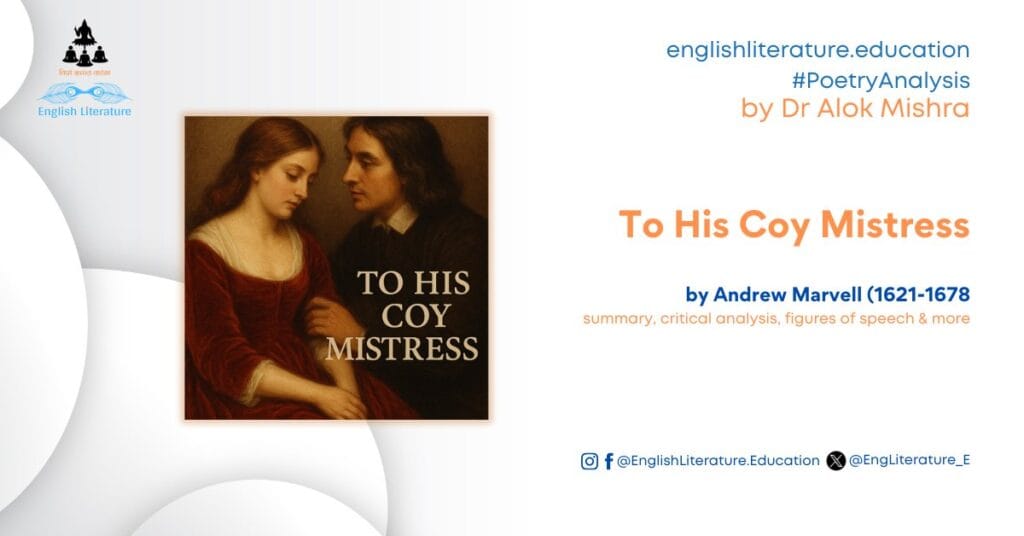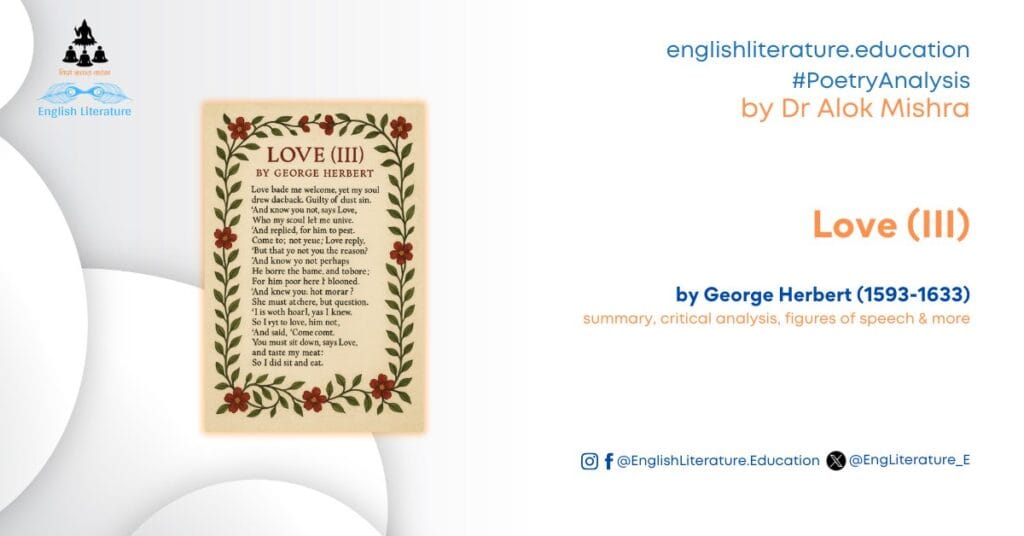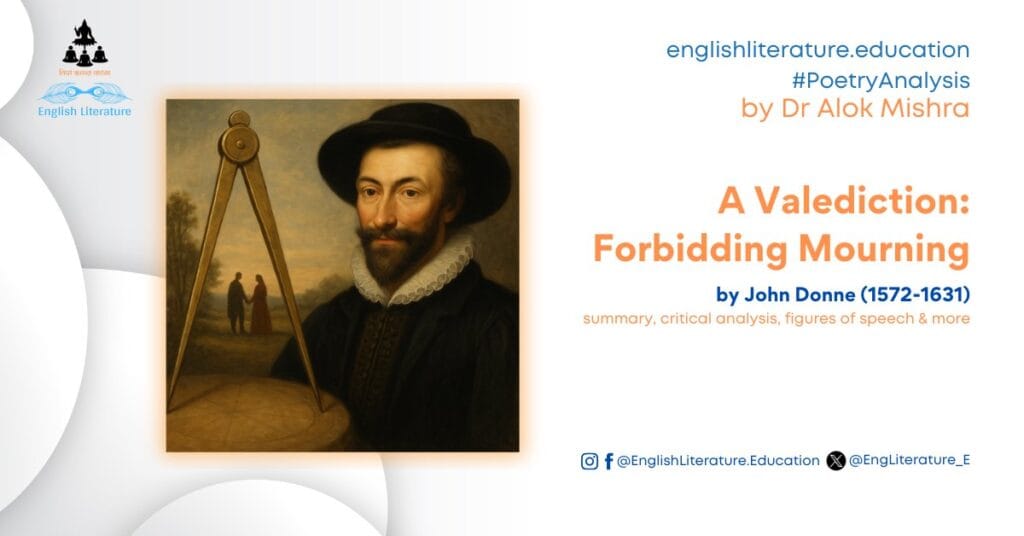George Herbert (1593–1633), one of the major English metaphysical poets of the seventeenth century, occupies a singular position in devotional poetry. His work is marked by a synthesis of metaphysical wit and spiritual introspection, combining intricate poetic form with profound theological inquiry. “The Collar,” one of the most striking poems in The Temple (1633), dramatises an intense spiritual conflict between rebellion and submission, freedom and obedience, despair and divine reconciliation.
The title itself is a nexus of meanings: “collar” suggests at once the clerical collar symbolising Herbert’s priestly vocation, the yoke of religious obedience, and the restraining bond that the speaker seeks to cast off. Yet by the poem’s end, the word’s phonetic echo—“Caller”—reveals divine presence and grace, transforming protest into reconciliation (Martz, 1954). The wordplay enhances the metaphysical purview of the entire poetic setup.
Composed during a period of intense personal and religious struggle, “The Collar” reflects Herbert’s own life as a clergyman torn between worldly ambition and spiritual duty. Through its restless rhythm, fragmented syntax, and shifting tone, the poem dramatises a soul’s revolt against divine constraint and its ultimate surrender to God’s call. It is both a confession and a conversion—a metaphysical parable of sin, defiance, and grace (Lewalski, 1979).
Summary of the Poem
The poem opens with a violent gesture: “I struck the board, and cried, ‘No more; I will abroad!’” The image of striking the table conveys anger and rebellion, a physical manifestation of inner turmoil. The speaker, frustrated by the apparent barrenness of his spiritual life, resolves to abandon his religious duties and seek freedom in the world.
He laments that his life has yielded only “thorns” instead of “cordial fruit,” and that his “sighs” and “tears” have consumed all joy and harvest. The repetition of “free, free as the road, / Loose as the wind” captures the illusion of liberation through defiance. Yet this freedom is illusory, for his thoughts remain entangled in self-reproach and divine awareness.
Midway, the voice turns inward: “Not so, my heart; but there is fruit, / And thou hast hands.” The rebellious energy begins to falter. The heart counsels recovery and action rather than despair. But the speaker’s confusion deepens—he oscillates between resolution and relapse.
Finally, as he “raved and grew more fierce and wild,” a quiet divine intervention occurs: “Methought I heard one calling, Child! / And I replied, My Lord.” The moment of recognition transforms defiance into submission. The poem closes not with argument but with graceful obedience—a serene acceptance that dissolves the storm of rebellion (Fish, 1972).
Theme and Subject Matter
At its core, “The Collar” dramatises the spiritual psychology of rebellion and reconciliation. Herbert’s speaker experiences a crisis of faith, an anguished perception that religious obedience has yielded only suffering. His cry of “No more” expresses both exhaustion and revolt against divine servitude. The poem’s title thus embodies tension between constraint and calling, bondage and belonging.
Thematically, Herbert explores:
The Paradox of Freedom: The speaker believes freedom lies outside the bounds of divine service (“I will abroad”), but the poem reveals that true freedom arises in obedience.
The Futility of Self-Will: His attempt to justify rebellion through reason (“Have I no harvest but a thorn?”) exposes the spiritual sterility of self-centred logic.
The Experience of Grace: The final two lines enact grace as a sudden, unearned revelation—a divine voice restoring the lost soul.
The Nature of Spiritual Struggle: Herbert captures the psychological realism of religious doubt—a soul torn between divine vocation and human desire.
The poem thus stages the metaphysical drama of the Christian soul, enacting the process of sin, repentance, and redemption through the language of inner conflict (Summers, 1954).
Structure and Form
“The Collar” consists of thirty-six irregular lines, lacking a consistent meter or rhyme scheme. This formal irregularity mirrors the spiritual chaos of the speaker’s mind. The lines vary dramatically in length—from brief outbursts like “Away! take heed; / I will abroad” to longer, meandering reflections. This volatility reflects the oscillation between anger and despair, between rebellion and reflection.
The poem’s structure can be divided into three movements:
Rebellion (Lines 1–16): The speaker’s outburst and justification of revolt.
Conflicted Reasoning (Lines 17–28): Rationalisation of freedom, mingled with self-doubt.
Revelation (Lines 29–36): The divine call and submission to grace.
Herbert’s use of enjambment and syntactic disorder enhances the impression of emotional turbulence. For example, “Recover all thy sigh-blown age / On double pleasures: leave thy cold dispute” propels thought forward breathlessly, reflecting the speaker’s impatience. The absence of rhyme creates a feeling of restlessness, which resolves only with the quiet balance of the final couplet—“Child! / My Lord.”
Critics have noted that the poem’s structural disarray itself enacts the process of spiritual disobedience, only to be brought into order by the divine word at the end (Patrides, 1974). The irregular form thus becomes a theological metaphor for disorder yielding to grace.
Tone and Mood
The poem’s tone shifts dramatically—from rage and defiance to exhaustion and, ultimately, humble surrender. At first, Herbert’s voice is tempestuous and accusatory: “Have I no harvest but a thorn?” conveys the bitterness of perceived divine neglect. The mood is one of resentment and despair—a lament of unfulfilled service.
As the poem progresses, however, the tone grows introspective. The phrase “Not so, my heart” marks the first turning point, signalling self-awareness. The mood softens, though conflict persists. Finally, the quiet tenderness of “Child!” and “My Lord” transforms the atmosphere into serenity and reverence.
This tonal modulation is crucial to the poem’s spiritual power: Herbert captures not a static sentiment but a spiritual drama—a conversion enacted in real time (Empson, 1951). The transition from storm to stillness mirrors the passage from rebellion to reconciliation.
Imagery and Symbolism
Herbert’s imagery draws richly on biblical and agrarian symbolism, reflecting his theological imagination and pastoral vocation. The recurring images of harvest, wine, corn, and thorns evoke scriptural metaphors of spiritual fruitfulness and barrenness.
“Harvest” and “Corn” symbolise divine reward and spiritual nourishment. Their loss signifies sterility of faith: “Have I no harvest but a thorn / To let me blood?”
“Wine” alludes to Eucharistic joy, dried up by the speaker’s sighs—a potent image of lost grace.
“Thorn” evokes both suffering and the curse of sin, echoing Genesis 3:18 and the crown of thorns Christ bore.
“Cage” represents spiritual confinement; the soul feels imprisoned by religious duty.
“Rope of sands” expresses the futility of self-made moral constraints—illusory bonds that crumble under pressure.
Herbert’s central symbol, however, is the collar—a multilayered image uniting themes of restraint, servitude, and divine calling. It simultaneously evokes the clerical collar, the yoke of Christ (Matthew 11:29), and the metaphoric tether of obedience. The poem’s pun on “Collar” and “Caller” signifies transformation: the very bondage the speaker resists becomes the means of grace (Hutchinson, 1941).
Thus, Herbert’s symbolism integrates the physical and the spiritual, typical of metaphysical poetry, grounding divine truths in tactile imagery.
Language and Style
Herbert’s diction in “The Collar” is deliberately colloquial and impassioned, reflecting emotional immediacy rather than polished decorum. The poem’s opening verb—“I struck”—is violently concrete, setting the tone of physical agitation. The frequent use of imperatives (“Forsake thy cage,” “Call in thy death’s-head there”) creates dramatic urgency, as if the speaker is exhorting himself.
The syntax is often broken and abrupt, with enjambment that mirrors disordered thought. The rhythm alternates between long, declamatory lines and short, clipped bursts, reproducing the rhythm of anger and repentance.
Herbert’s style exemplifies metaphysical concision—condensing spiritual paradox into vivid, tangible language. The metaphors (“rope of sands,” “cordial fruit”) embody spiritual abstractions in sensory form. The final dialogue, two words of divine exchange, condenses an entire theology of grace into a brief, dramatic resolution.
This stylistic compression, violence giving way to silence, reveals Herbert’s mastery of metaphysical rhetoric as a vehicle for theological revelation (Wilcox, 2007).
Figures of Speech
Herbert’s artistry lies in his ability to use rhetorical and figurative devices not merely as ornamentation but as vehicles of spiritual meaning.
Metaphor: The poem abounds in metaphors of bondage and liberation—“cage,” “rope of sands,” and “collar” symbolise the tension between spiritual constraint and worldly freedom.
Personification: The heart becomes a speaking interlocutor—“Not so, my heart”—suggesting inner dialogue between reason and emotion.
Alliteration: Phrases like “sigh and pine,” “cordial fruit,” and “harvest but a thorn” create rhythmic intensity and emotional texture.
Paradox: The poem’s theological core is paradoxical—obedience as freedom, surrender as victory, bondage as salvation.
Irony: The speaker’s declaration of independence (“I will abroad”) ironically exposes his dependence on divine calling; even rebellion presupposes God’s presence.
Pun: The climactic pun between “Collar” and “Caller” is perhaps Herbert’s most profound wordplay, converting a symbol of oppression into one of grace.
These devices collectively embody the metaphysical fusion of wit, intellect, and devotion—the hallmarks of Herbert’s poetic theology.
Philosophical and Theological Dimensions
“The Collar” is a profound exploration of Christian existential rebellion—the soul’s struggle against divine sovereignty and its ultimate surrender to grace. Herbert dramatises a spiritual dialectic rooted in Augustine’s theology of will and grace: the restless human will (“curvatus in se,” turned inward) must be reoriented toward God’s calling (Augustine, Confessions).
The speaker’s rebellion arises from a distorted perception of divine servitude as constraint rather than vocation. His cry for freedom—“My lines and life are free”—reflects the Pelagian illusion of self-sufficient will. But his subsequent despair reveals the futility of self-liberation: “Thy rope of sands, which petty thoughts have made.”
Herbert thus enacts the theology of bondage and freedom articulated by St. Paul: “For when I am weak, then am I strong” (2 Corinthians 12:10). True freedom is not escape from divine law but reconciliation within it.
The final moment—God’s voice calling “Child!”—embodies the Augustinian concept of prevenient grace: divine love initiates reconciliation before human effort can respond. The speaker’s answer, “My Lord,” is the moment of metanoia—a conversion of the will.
In metaphysical terms, the poem enacts the paradox of rational revolt and mystical resolution: intellect rebels, spirit yields, and grace triumphs. The poem thus reflects Herbert’s larger theological project—to reconcile human passion with divine order through poetic mediation (Summers, 1972).
In his own words, Herbert finds true freedom in serving his master, Jesus Christ. He writes in a letter:
“…he shall find in it a picture of the many spiritual conflicts that have passed betwixt God and my soul, before I could subject mine to the will of Jesus my Master; in whose service I have now found perfect freedom…”
(quoted by Knights, 1978)
Critical Appreciation
“The Collar” stands among Herbert’s most psychologically intense and structurally daring poems. It exemplifies his ability to translate theological experience into a dramatic monologue, transforming personal conflict into universal meditation.
Herbert’s innovation lies in his dramatic immediacy: unlike conventional devotional poetry, “The Collar” does not describe repentance retrospectively but enacts it dynamically. The reader experiences the oscillation of rebellion, confusion, and grace in real time. This dramatic method anticipates the interior monologue of later poets like Browning and T.S. Eliot.
Critically, “The Collar” also exemplifies Herbert’s integration of metaphysical wit with emotional sincerity. Unlike John Donne, whose metaphysical conceits often remain intellectual, Herbert’s wit serves a pastoral function—resolving confusion through divine clarity.
The poem’s theological insight lies in its portrayal of spiritual dialectic rather than moral didacticism. The speaker’s revolt is not condemned but understood as part of the soul’s purification. Herbert portrays faith not as static belief but as dynamic wrestling with God (cf. Jacob’s struggle in Genesis 32:24–30).
The climactic exchange, two lines of perfect symmetry, captures Herbert’s theology of grace in miniature. The word “Child” asserts divine authority and intimacy; “My Lord” expresses humility and restored relationship. In these four syllables, Herbert resolves the entire metaphysical crisis, demonstrating that divine grace transforms rebellion into obedience without annihilating individuality.
Thus, “The Collar” dramatises the mystery of divine-human dialogue, where language itself becomes the site of revelation (Fish, 1972).
From a stylistic standpoint, the poem’s rhythmic irregularity and syntactic disarray prefigure the modernist fragmentation of consciousness. Yet its resolution affirms metaphysical order – language redeemed by the Word. Herbert’s art thus embodies the metaphysical unity of faith and form: the poem’s chaos finds coherence in divine speech.
Conclusion
“The Collar” encapsulates George Herbert’s genius as both poet and theologian. It fuses passionate emotion with intellectual precision, dramatising the soul’s rebellion and reconciliation within the economy of grace. Through violent imagery and musical form, Herbert translates the inner experience of spiritual conflict into universal allegory.
The poem’s enduring power lies in its dialectical energy—its refusal to simplify faith into serenity. Herbert understands that belief is born out of struggle, that divine order is glimpsed only through human disarray. “The Collar” thus remains a quintessential expression of metaphysical poetics, where theology, psychology, and aesthetics converge.
In the final quiet dialogue between the soul and God, Herbert distils the entire Christian drama of fall and redemption into a moment of linguistic and spiritual grace. What begins as rebellion ends in recognition; what starts as noise concludes in silence.
As such, “The Collar” is not merely a devotional poem but a metaphysical confession of the human condition—the restless heart seeking rest in the divine Caller.
Selected References
Empson, W. (1951). The Structure of Complex Words. London: Chatto & Windus.
Fish, S. (1972). Self-Consuming Artifacts: The Experience of Seventeenth-Century Literature. University of California Press.
- Knights, L. C. (1978). “George Herbert: Resolution and Conflict”. George Herbert and the Seventeenth Century Religious Poets. W. W. Norton.
Hutchinson, F. (1941). The Works of George Herbert. Oxford University Press.
Lewalski, B. (1979). Protestant Poetics and the Seventeenth-Century Religious Lyric. Princeton University Press.
Martz, L. L. (1954). The Poetry of Meditation. Yale University Press.
Patrides, C. A. (1974). George Herbert: The Complete English Works. Oxford University Press.
Summers, J. H. (1954). George Herbert: His Religion and Art. Harvard University Press.
Wilcox, H. (2007). The English Poems of George Herbert: A Reading Edition. Cambridge University Press.
By Dr Alok Mishra
for English Literature Education




